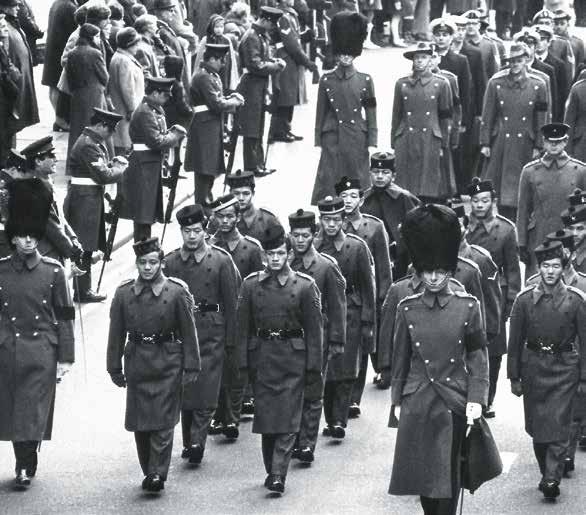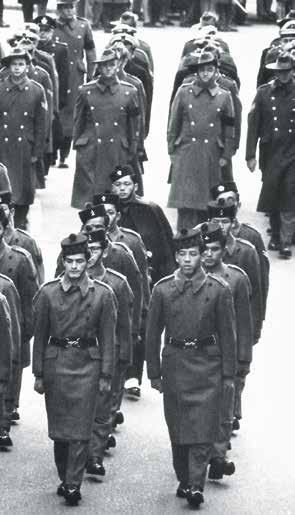
6 minute read
The President
from 6 GR Journal 100
MESSAGE FROM THE PRESIDENT
Thankfully, Brexit was not the only story of 2019: in November at our Reunion we celebrated the 60th Anniversary of the Regiment being awarded the royal title “Queen Elizabeth’s Own”; the Trust was able to purchase Colonel Cecil Allanson’s medals, which have now been added to the Sari Bair memorabilia in our Gurkha Museum; the family of Hugh Wallace kindly presented his well-known portrait to the Museum where it will join Hugh’s Elizabeth Cross; our successors, the Royal Gurkha Rifles (RGR), marked their 25th Anniversary in July with a parade in the UK attended by their Colonel-in-Chief, HRH The Prince of Wales, and where we were represented by our new Chairman, Duncan Briggs. In June Duncan organised a wonderful Memorial Service on the 75th Anniversary of the death of Captain Michael Allmand VC at his parish church of St Edward the Confessor in Golders Green, where we were joined by both family members and RGR representatives. In October all of us rejoiced when Nirmal Purja, ex-Queens Gurkha Engineers, set a record when he conquered the 14 highest mountains in the world in a mere seven months.
And in 2020 we celebrate the 100th anniversary of Bill Slim joining our Regiment – as Field Marshall William Joseph Slim, 1st Viscount Slim, KG, GCB, GCMG, GCVO, GBE, DSO, MC, KStJ, one of the greatest wartime warriors of the British Army. This edition of the Journal is dedicated to him.
For many of us, service with the Brigade of Gurkhas has been overshadowed by seemingly endless rounds of redundancies and manpower cuts since 1967. Indeed, there have been some who have constantly preached doom and gloom, but I am delighted to say such prognoses have proved wrong: over the next five years our Brigade will grow by nearly 75%, with recruiting being increased from 270 in 2018, to 400 in 2019 to 432 from 2020 onwards.
Growth started slowly (and rather discreetly) in 2016, two years after the last round of major redundancies, as we took on 233 new posts, ranging from the Allied Rapid Reaction Corps (ARRC) Support Battalion to training establishments across the army. Gradually more posts have been acquired and early last year the latest package was announced, which sees the conversion of the ARRC Support Battalion to GURTAM (Gurkha Trained Adult Males), two additional squadrons for both Queen’s Gurkha Signals and the Queen’s Own Gurkha Logistic Regiment, and an additional squadron for Queen’s Gurkha Engineers.
Furthermore, five new rank-rich specialized Infantry Battalions, with the role of training other armies in high-threat environments, are being formed and these will include the Third Battalion of the Royal Gurkha Rifles – 3 RGR. Other enhancements to establishments will mean that the Brigade will grow from some 2,560 to over 4,700.
All this is vital in the light of the Versatile Engagement, which only offers soldiers an initial 12 years service, with pensionable service to 24 years by selection only. Our poor conversion rate, necessary to avoid promotion blockages and retain high deployability, caused many high-grade men to transfer out of the Brigade at the five-year point to units where there was less competition and hence better conversion prospects. But the new establishments now provide more senior posts and lower demands on deployability, while the point at which our men can transfer to UKTAM units has been raised to seven years. These changes will have a major impact on conversion rates (one unit now has an unheard of 100% conversion rate) and lead to better retention and more contented soldiers.
That our Brigade has survived protracted assaults over the last 50 years and is now growing is due to the hard work put in over many years by HQ The Brigade of Gurkhas and our ability to recruit exceptional individuals from Nepal. Even more importantly, our Gurkha soldiers have earned the right to continue to serve: our Brigade demonstrates excellence in all we
do and have shown that, even in adversity, the Gurkha soldier continuously sets the highest standards.
Both battalions of RGR continue to excel. 1 RGR is now back from Afghanistan (Op TORAL) and have had elements on exercise in Croatia and Jordan and will be moving to Brunei in mid 2020. 2 RGR have also been kept busy with deployments to Australia, Thailand and Zambia, as well as continuing to work closely with the Royal Brunei Armed Forces, and Corporal Subash Rai won the Queen’s Medal at Bisley.
As many will know, all the RGR Companies bear a battle honour from one of the Antecedent Regiments; with the formation of 3 RGR new allocations have been made and one company will bear the title “Krithia”, won by 1/6 GR in Gallipoli. Our preferred allocation was “Gurkha Bluff”, but when RGR was formed this battle honour was excluded as there was a limit on battle honours that could be carried forward. However, 3 RGR will in practice celebrate Gurkha Bluff – a brave and memorable action – as an intrinsic part of Krithia.
Our Colonel Commandant and Chairman of the Gurkha Welfare Trust, Lieutenant General Sir Nick Pope, was appointed Knight Commander of the Order of the Bath in the Queen’s Birthday Honours List but will be handing over in 2020, while Colonel James Robinson has finished a mammoth seven-year stint as Colonel Brigade of Gurkhas, and has rightly been appointed a Commander of the Order of the British Empire. A group of us were able to ‘lunch-out’ James and, on behalf of all of us, I thank both Nick and James for all they have done for our

Brigade – simply see the foregoing!
I would end by expressing my gratitude to all those who, unsung, keep our Association going: our Chairman and Members of his Committee; the Trustees of the Regimental Trust, especially Michael Channing, who is leading the Committee to establish a Regimental Memorial in Nepal; James Herbert, who runs our website; Rick Beven, our redoubtable Editor; but above all our members, who continue to support the Association and without whom we would cease to exist.
Jai Sixth!
John Anderson
THE FUNERAL OF FIELD MARSHAL VISCOUNT SLIM
John Anderson writes:
Field Marshal Viscount Slim, KG, GCB, GCMG, GCVO, GBE, DSO, MC, KStJ died at the age of 79 on 14 December 1970, 50 years after he had joined 6 GR. I was told to get to the Army School of Languages at Beaconsfield, to organise our Language Students into a parade contingent and to lead them on the funeral parade on 22 December at St George’s Chapel, Windsor. On arrival at Beaconsfield we were given bales of ancient and very rigid greatcoats, without buttons. Two days of frantic sewing: of buttons and, because the coats were so stiff, of all the creases and folds.
Then to Windsor Barracks, where fearsome Guards WOs taught us the rather odd Funeral pace – a cross between slow and quick march, but with no arm swinging and 30" paces – not easy for our men. I was fortunate that a good friend, Sgt Dhanparsad Gurung 2 GR (later Captain (QGO)), was part of the contingent so I made him Right Marker, and he quickly got a grip of the odd useless soldier. After several shambolic rehearsals, fighting for space on the square with the Australian and Guards contingents, we discovered that we would be leading the parade through Windsor to the chapel, since seniority worked from the cortège; this made command much easier as I had to be behind our contingent and we simply had to follow a Guards officer to the chapel.
On the return to barracks, and after the order “At the correct Gurkha pace, quick march” we got back with only one slight hiccup – the Australian Contingent, now in front of us, were halted in the middle of the road and ordered “Right Turn and fall-out into that Pub”. Sadly, we did not follow. There were three 6 GR soldiers in the contingent but alas I can only identify one; LCpl Sardaparsad Gurung, later to be Pipe Major and now sadly deceased, at the back. What an honour!










